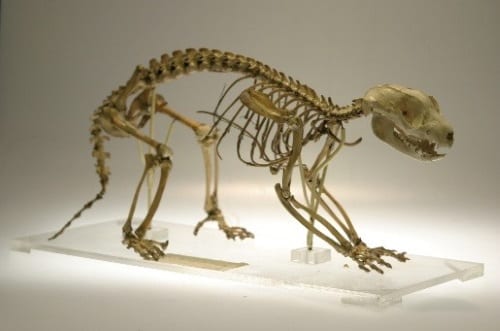Specimen of the Week 336: The Common Spotted Cuscus Skeleton
By Christopher J Wearden, on 30 March 2018
Good afternoon to all Specimen of the Week lovers. Before I get started with my inaugural blog I’ll take this opportunity to introduce myself. I’m Chris – museum enthusiast/cyclist/zoologist-in-training. I’m also the new Visitor Services Assistant at the Grant Museum. I’ve taken time over my first couple of weeks familiarising myself with the wonderful collections we have on display, and after careful consideration I’ve decided on a specimen that is very close to the heart of our museum manager. It’s the…
**Common spotted cuscus**
The common spotted cuscus (Spilocuscus maculatus) is a marsupial related to possums. Marsupials are animals that give birth to young after a short gestation period – in the case of the common spotted cuscus 14-20 days. The young then finish off their development with a long period of suckling on the teat. Well-known marsupials include kangaroos, koalas and wombats. The common spotted cuscus is found in the forests of the far northeastern tip of tropical Australia, as well as the rainforests of New Guinea. They are predominantly arboreal, meaning they spend most of their lives in trees.
Spot the difference
Despite the somewhat misleading name, only male common spotted cuscuses actually have spots, whereas females are grey/white and unspotted. In July, females have been heard making a high-pitched hiss to attract males. Distinctive features both males and females share are yellowish/pinkish skin and a rim around their large eyes – these large eyes are essential for a nocturnal lifestyle.
Going it alone
The common spotted cuscus is a solitary creature which only interacts with others during mating season. Males are aggressive and cannot be housed together in captivity. Males have a number of techniques to deter rivals including the ability to emit a penetrating odour from scent glands at the bases of their tails, as well as a powerful kick and scratch.

A common spotted cuscus. Image: Aviceda on Wikipedia. CC BY-SA 3.0
Too much monkey business
Due to its arboreal lifestyle and physical similarities, the common spotted cuscus was initially misidentified as a type of monkey. We now know that there are no monkeys in Australasia. Cuscuses and monkeys move in a similar way and both use their tails to grip branches when travelling through the forest. Their sluggish demeanour has also seen cuscuses compared to sloths, although this in itself is a somewhat lazy comparison as cuscuses are much more active than their tree-dwelling friends in South America.
All tucked in
One notable behaviour of the common spotted cuscus is the ability to build a sleeping platform for themselves out of leaves and twigs. They have also been observed tucking palm fronds around their body. As nocturnal animals they spend their days sleeping on branches at a height between ten to fifteen metres, making them vulnerable to predators such as pythons and birds of prey. The ability to construct these sleeping platforms not only provides them with an environmentally-friendly bed, but also some much needed camouflage.
References
Grzimek, Bernhard (1990). “Spotted Cuscus”. Grzimek’s Encyclopedia of Mammals. South Orange, NJ: McGraw-Hill Company
Van Dyck, Steve & Ronald Strahan (2008) ‘’Common Spotted Cuscus’’. The Mammals of Australia. .Sydney: Angus and Robertson
Chris Wearden is the Visitor Services Assistant at the Grant Museum of Zoology.
 Close
Close


